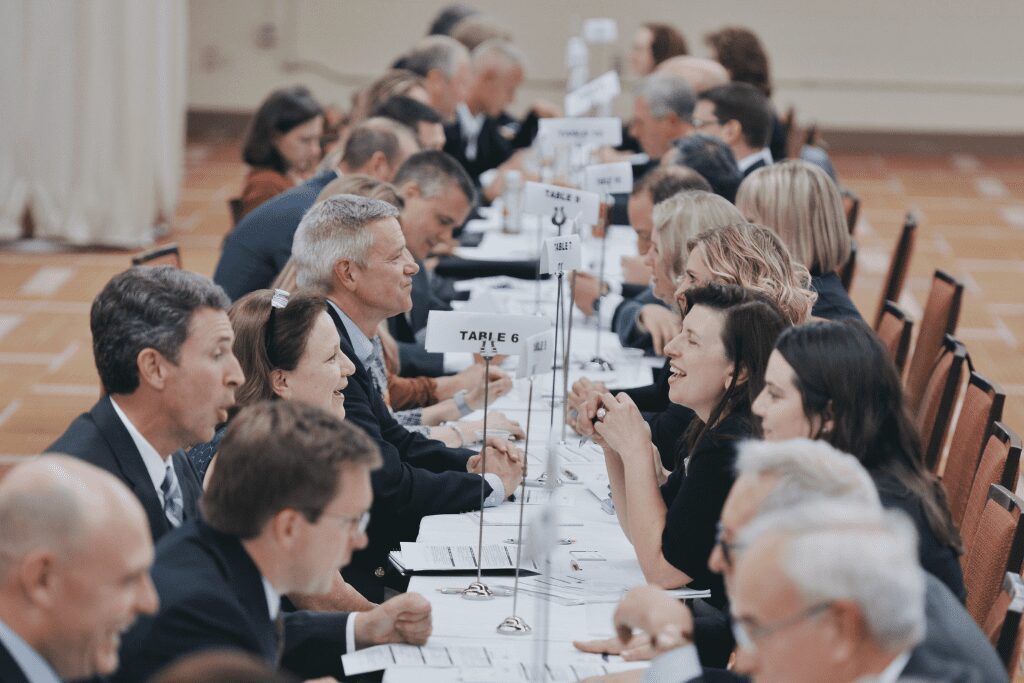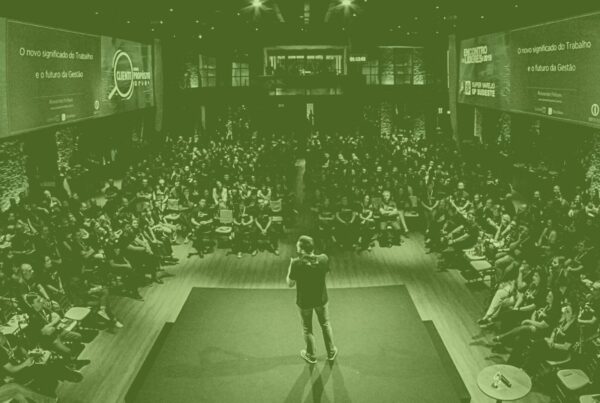Events are all about creating connections – connections between attendees, an organization and its members, a brand and its audience. No matter the industry, networking games are one of the best ways to connect a community. But the importance of networking often gets overlooked in the grand scheme of the event planning process. But it shouldn’t. Sure, a mix and mingle welcome reception is something, but is it really the best way to bring people together? And is it even memorable?
The short (and straightforward) answer is no. We’re not here to hate on cocktail mixers, we just think there’s a better way to connect your attendees.
Event planners often offer cocktail mixers as a relaxed way to get to know one another. But the thing is … They’re not that relaxing. For most people, unstructured networking events are intimidating. The thought of approaching random strangers who they know nothing about isn’t a walk in the park. It takes courage, and even with it, it can be challenging to come across the right people.
Instead, consider offering a different type of icebreaker activity. Consider, instead, offering networking games. They’re more effective, engaging, efficient, and fun! Here are 8 options to choose from and more on why we’re choosing these over anything else. Not only will they elevate the networking experience at in-person events, they can also serve as an inspiration for networking in a virtual setting as well as hybrid event networking.
Networking Games That Incorporate Technology
1. Speed Networking
You’ve probably heard of speed dating, but have you heard of speed networking? It’s an accelerated way to maximize the number of new connections attendees can make in a short amount of time. It also takes the awkwardness out of having to approach random people. Each round has a set amount of time and attendees rotate accordingly at the end of each round. We recommend each round lasting 5-7 minutes. Enough time to get to know another but not enough that it’s a waste of time if you don’t have anything in common.
And if you’re interested in increasing the quality of connections in addition to the quantity, consider using matching software to pair people together who share the same interests. It’s quite literally matchmaking for professionals. All you have to do is decide how you want to categorize your attendees. From there, the software will create a survey that attendees will fill out when registering for the event. They can rate how interested they are in meeting people from the categories anywhere from not at all interested to very interested. The software takes these responses and creates customized schedules for each attendee. Talk about a personalized event approach!
When attendees arrive at the event, they’ll get their schedule, which includes background information, contact information, and starter questions for each of the people they’re scheduled to meet with.
The fast-paced nature of speed networking events makes this session format engaging and efficient. In fact, the average 90-minute networking session with 100 participants usually generates around 300 new connections. But, a speed networking event of the same size will generate more than 1,000. That’s 333% more meaningful connections!
Matching technology also allows you to determine an event objective or goal. You can offer peer-to-peer events (probably the most popular), exhibitor/attendee events (to match potential buyers with sellers), and mentor/mentee events for those looking to building industry relationships.
2. Roundtables
We aren’t talking random roundtables. This is an article about better networking after all. We’re talking targeted roundtables. Targeted roundtables are group networking, but with a strategy. Decide how you want to categorize your attendees; job title, geographical location, interests within the industry, you name it – and break people up accordingly. While this might sound like a lot of manual manipulation on your end, it’s really not. And here’s why. There is a technology that already exists that can create strategic seating assignments for you! And it’s all at the touch of a button.
At the event, we recommend you use prompts to help guide the conversations. These can be a mix of professional and more personal questions. It could include questions like: What is the main reason you are attending this event? What’s the biggest challenge you face at work right now? What to hope to take away from this event? Which session are you most excited about? Do you have other coworkers attending the event with you or are you by yourself? Have you been to this city before? What do you like to do outside of work? What’s your favorite place to travel to?
Group networking can be a lot less intimidating than one-on-one networking and help people feel more at ease. It’s also a networking format that focuses on collaboration. After some initial networking, you can also have each table compete in a teambuilding contest. The opportunities are endless.
 Networking Games That Focus On Teamwork.
Networking Games That Focus On Teamwork.
3. Scavenger Hunts
Scavenger hunts are a great way to get people moving. And who doesn’t love some good, old-fashioned (and friendly) competition? There are a number of organizations and corporations that plan event-wide and city-wide scavenger hunts, designed specially to bring your attendees together in a way that promotes teamwork.
With challenges like visiting sponsor booths, posting photos with a conference hashtag, answering questions about keynote speakers, and finding attendees who share the same interests, scavenger hunts can be an extremely effective tool in increasing attendee and exhibitor engagement.
With scavenger hunt technology, event planners can work with experts to create a program that uses QR codes and photos to increase interaction between attendees. Whether your goal is to increase brand awareness, engage your attendees in a unique way, or simply offer a fun activity for your event-goers, scavenger hunts are a unique networking game for your conference, annual convention, or large-scale corporate event.
How does something like a conference scavenger hunt work? It’s easy! Your participants will download a scavenger hunt app via a link you send out. They can then see an entire list of different challenges relating to the event. For each challenge that they complete, they earn points, which eventually add up towards a prize. Challenges could include things like:
- Visit 3 sponsor booths that seem most interesting to you
- Answer a multiple-choice question about the keynote speaker
- Share a team photo on social media with the hashtag [insert conference hashtag]
- Find someone who has the same job title as you
- Refer a friend (coworker) who should attend this event next year
In addition to these types of challenges, you can also incorporate vendors and presenters so everyone feels more involved and engaged. Share the photos people uploaded to a TV screen in real-time and take advantage of the leaderboards most scavenger hunt apps offer so that your participants can see where they stand (which encourages competitiveness) and how far they are from winning a prize.
This type of networking game is especially great for people who tend to hate traditional networking events. It gives them an excuse to meet fellow event-goers and feels more like fun than it does networking.
And by offering a prize (or prizes) at the finish, participants are encouraged and motivated to work together to overcome each challenge. It’s networking, with a twist of teamwork.
City-wide events can also be especially fun, and an unconventional way to see a city. You picked the location for a reason: maybe it’s the warm weather in Tampa, the cuisine in New Orleans, or the mountains in Denver. Wherever you are, your attendees will appreciate getting to do some sightseeing instead of sitting in a convention center for four straight days. City-wide scavenger hunts can add in even more fun. Eat a meal at this famous restaurant. Take a photo in front of this tourist attraction. Try this city’s signature drink. It can really help people find a balance between learning and experiencing.
 Networking Games That Are Contest Driven
Networking Games That Are Contest Driven
4. Business Card Collection Contest
If you are dead-set on a more ‘mix and mingle’ networking format, making the session into a contest can go a long way in increasing the likelihood that your attendees will meet more people (and the right people). Instead of a free-for-all networking session format, make it a contest to see who can meet the most people and in turn collect the most business cards.
Offering a prize to the winner isn’t a bad idea either. Sometimes attendees, especially more introverted attendees, need a little extra push.
If this is a route you end up taking, be sure to offer another networking event that’s not as fast-paced or transition into it after the contest ends. This way, your attendees can further connect with the people they met more briefly in the business card collection contest. Because effective networking, after all, doesn’t happen by just swapping contact information. But it does get the conversations started, and that’s certainly something.
 5. Human Bingo
5. Human Bingo
Another networking game you can try at your next conference or event is human bingo. To offer a human bingo game, you’ll need to create bingo cards. These are typically a 5×5 matrix. Fill the boxes with things that are relevant to your unique industry and audience. If it’s a marketing conference, you could fill it with things like:
- Works in digital marketing
- Specializes in SEO
- Manages client paid social campaigns
- Has worked in the industry for 5+ years
- My company is currently hiring
- Is searching for a mentee
Then, you’ll have your attendees walk around the room and check off boxes as they meet people who fit into the boxes. The first one to BINGO wins. It’s really that simple.
You can also add in less industry-focused statements if you want to make it a little more laid-back. Here are some ideas for those types of statements:
- Has traveled to another country this year
- Has a dog
- Is watching the same TV show as you
- Has seen your favorite artist in concert
Sometimes, these types of conversation starters can help your attendees feel more at ease and relaxed. And the more relaxed they are, the more they’re themselves. And that positive, authentic energy is more likely to carry over to other sessions.
 Networking Games That Help Your Attendees Quickly Get To Know Each Other
Networking Games That Help Your Attendees Quickly Get To Know Each Other
6. Quick Fire Questions
This is a quick, easy-to-set-up networking game. Simply have your attendees find a partner (anyone in the room) and give them 1 minute to fire off questions. To make it easier, consider displaying sample questions on a screen in the area in case they run out of ideas.
This type of networking is also fast-paced, without any of the pressure to force a conversation or to keep it going longer than necessary. We often hear from participants that one of their biggest complaints about mix and mingle events is getting stuck talking to the wrong person. But with quick-fire questions, it is essentially just a fast-paced Q&A. After you’ve given enough time for each attendee to meet with 10-15 people, give them some time to seek out the people they want to learn more about.
Now that the room is warmed up and participants have a better idea about who to approach, they’ll feel much more confident.
Questions could include things like: What is your job title? What company do you work for? How would you describe it in one sentence? Is this your first time attending? What types of people do you want to network with? What is your number one networking goal?
7. People Organizer
This is a great way to group attendees together who have similar backgrounds and shared interests. To start, have your attendees stand in a big group together. And then have them organize into smaller groups based on specific criteria. For example, by position title, work history, job specialty, favorite sports team, etc.
Your attendees will be able to see exactly who they need to be approaching for further conversation. And it helps to give them a visual representation of the types of people who are attending the event.
 8. Switch Sides If …
8. Switch Sides If …
For this one, split your attendees into two groups. One side will be a “yes” side and one side will be a “no” side. Read through questions one at a time and ask your attendees to switch sides so that they are always on the side that reflects their feeling or answer to whatever it is you’re reading. For example, I work in the Midwest. I have belonged to this association for more than 2 years. The company I work for has more than 100 employees. I have been to Italy.
In Conclusion: Let The Networking Games Begin!
We hope these networking games help jump-start your event planning process! We know there’s a lot that goes into planning a successful event. From the venue to programming, it can be overwhelming and you can’t always dedicate the time you want to every aspect of an event.
Luckily, a lot of these networking solutions offer technology that greatly reduces the administrative time it takes to plan a networking session, which allows you to focus on other areas of event planning.
So, next time you feel stuck and unsure of how to more creatively connect attendees, consider using one of the options from this list. Not only are these games fun, but they’re also effective. If there’s one piece of advice we want to leave you with, it’s to do your best to strategically bring the right people together. Networking is usually one of the top reasons people attend events, but if they leave the conference or event without having met people that were worthwhile, they probably won’t come back next year.
It’s so important to listen to your attendees and take their experience into consideration. Maybe this year you tried human bingo and people liked it but didn’t love it. Next year, you can try speed networking. Or maybe you did speed networking this year and everyone loved it. Now you know to keep offering that session.
And now, let the games begin!
Editor’s Note: This post was originally published on October 26th, 2018.











